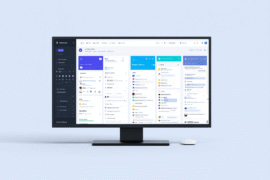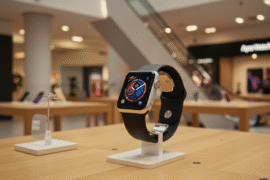This article may contain references to products or services from one or more of our advertisers or partners. We may receive compensation when you click on links to those products or services. Nonetheless, our opinions are our own.
The information presented in this article is accurate to the best of our knowledge at the time of publication. However, information is subject to change, and no guarantees are made about the continued accuracy or completeness of this content after its publication date.
Managing your money has never been easier. In 2025, neobanks play a central role in the financial lives of millions of users. The quality of their mobile application is now a key differentiator—far beyond simple design. Why? Because almost everything now happens through it: payments, budgeting, investing, transfers, alerts, currency conversion… But beware, not all apps are created equal. Some stand out for their ergonomics and rich feature sets, while others stick to the basics. Let’s take a closer look at the apps that truly rise above the rest.
Why has the mobile app become a decisive factor?
With the massive digitalization of banking services, the mobile app has become the real storefront for user experience. It’s no longer just a consultation tool—it must now offer a smooth, intuitive, personalized, and comprehensive experience. To understand this shift, we need to consider the role smartphones now play in our daily financial management.
Banking in your pocket: now the standard
Making a transfer, blocking your card, tracking expenses, receiving a notification after a payment—all these actions have become as natural as sending a message. The smartphone is the new bank counter. No more queues, no more business hours. The user is autonomous, free to manage their money anytime, anywhere. And that changes everything, especially for younger generations who prioritize the mobile experience above all else. A bank without a seamless app instantly loses credibility.
What users expect in 2025
With the rise of mobile usage, user expectations have soared. In 2025, a basic app is no longer enough. Speed, intelligence, and clarity are must-haves. They want an interface that can anticipate their needs, save them time, and offer tools suited to their financial lifestyle.
Today’s users expect banking apps to offer:
- Instant notifications after every transaction
- One-click card freeze/unfreeze
- Expense tracking by category
- Savings or budgeting goals
- Real-time multi-currency management
- Instant transfers, even internationally
- 24/7 responsive customer service
Comparison of the best neobank apps
So which neobanks stand out in this context? Several apps lead the way thanks to advanced features and a thoughtful user experience. Here are the top four market leaders in 2025.
Revolut: the financial super-app
Revolut is often cited as the most complete neobank. Its app is a true financial toolbox: payments, real-rate currency exchange, investment management (stocks, crypto), savings vaults, virtual and physical cards, premium subscriptions… It covers almost all modern user needs.
Key strengths: sub-accounts in multiple currencies, automated transfers, and a powerful, visually rich spending analytics module. Users can set budget limits, receive targeted alerts, and create smart savings rules.
Revolut also integrates services like travel insurance, cashback bookings, and exclusive partner offers. Its interface is sleek and fast—but note: some features are locked behind premium plans. To learn more, read this feedback about Revolut!
N26: efficient simplicity
N26 wins users over with its simplicity and clarity. The app focuses on essential functions: an intuitive dashboard, automatic categorization, savings Spaces, and responsive support. Everything works smoothly—perfect for managing a daily budget.
Its strength lies in its clear navigation and real-time sub-account management via drag-and-drop. You can block your card or change the PIN in one click. However, it lacks advanced features like investing or in-depth currency management, making it better suited for everyday use than international needs.
Wise: the international transfer specialist
Wise is tailor-made for international users: freelancers, expats, and travelers. The app shines in currency management and cross-border transfers, letting you open local accounts in multiple currencies and convert at real rates with ultra-low fees.
Transparency is its strongest asset: no hidden fees, no inflated rates. While you won’t find savings or investment options, its razor-sharp focus on international efficiency makes it an indispensable tool for borderless banking.
Bunq: the flexible, colorful neobank
Bunq stands out with its fun, customizable interface. It offers automation rules, carbon tracking, ethical spending tools, and even multiple IBANs. Users can create personal financial logic in-app, making it unique among neobanks.
It appeals to tech-curious and eco-conscious users—but requires time to master. Advanced features require a subscription, but in return you get a vibrant, modular banking experience unlike any other.
Voted "Best Overall Budgeting App" by Forbes and WSJ
Monarch Money helps you budget, track spending, set goals, and plan your financial future—all in one app.
Get 50% OFF your first year with code MONARCHVIP
Which app suits which type of user?
Each app is tailored to a different profile. Choosing the best one depends on your needs, lifestyle, and financial habits. Do you monitor every transaction? Travel frequently? Or just want a clean way to manage direct debits? Start with your main use case.
For travelers or expats
Wise and Revolut are top picks. Wise leads in transparency and real-currency transfers. It’s ideal for holding and converting multiple currencies and offers bank details in various countries with zero surprises on fees.
Revolut goes further in functionality, adding travel extras like insurance, disposable virtual cards, or lounge access. It’s a digital Swiss Army knife for modern travelers—but only if you take time to explore it.
For effective daily budget management
N26 is the go-to for everyday use. Its clean interface and automated budgeting tools make it ideal for students and busy professionals who need clarity over complexity.
Bunq can also be suitable if you like to experiment and customize. Features like automatic savings or carbon footprint tracking offer a fresh take on personal finance.
For centralizing all banking and financial services
Revolut clearly dominates for users who want to centralize payments, currencies, savings, investments, and insurance in one app. It’s a true super-app—but it does require some onboarding effort.
If you want a 360° overview of your finances, Revolut is hard to beat. But make sure you’re ready to explore its full potential.
How to choose the right app?
There’s no universal answer. Choose based on your real habits, priorities, and financial comfort. Don’t just follow rankings or marketing—your needs should guide your decision.
Ask yourself: Do I want instant notifications? Auto-saving? Multi-currency support? Or just a clean, simple budget app?
Tips for making the right choice:
- Compare features available in your region
- Define your use case: simple tracking or full-featured finance management?
- Watch the fees: beyond subscriptions, check for hidden costs
- Test it first: try the free version to see if it fits your habits
The best app is the one you’ll actually use. If it feels clunky or you keep forgetting to open it, it’s probably not the right fit—no matter how well it scores online.
The verdict: which app stands out?
There’s no single winner, but each app shines in its own way:
Revolut is the most complete for 360° financial control, ideal for digital-native users who want everything in one place—but it has a steeper learning curve and paywalls.
N26 is perfect for minimalists and anyone who wants a fast, clean budgeting tool—great for students and professionals with no need for advanced features.
Wise is a must for international users who need real-time, cost-effective currency management—but it’s not a full-service banking solution.
Bunq is best for creative, engaged users who value customization and eco-responsibility—but it takes effort and curiosity to unlock its full value.
Bottom line: no app wins for everyone—but your needs will point you to the right one.

Reviewed and edited by Albert Fang.
See a typo or want to suggest an edit/revision to the content? Use the contact us form to provide feedback.
At FangWallet, we value editorial integrity and open collaboration in curating quality content for readers to enjoy. Much appreciated for the assist.
Did you like our article and find it insightful? We encourage sharing the article link with family and friends to benefit as well - better yet, sharing on social media. Thank you for the support! 🍉
Article Title: Which Neobank Has the Best App to Manage Your Accounts?
https://fangwallet.com/2025/07/24/which-neobank-has-the-best-app-to-manage-your-accounts/The FangWallet Promise
FangWallet is an editorially independent resource - founded on breaking down challenging financial concepts for anyone to understand since 2014. While we adhere to editorial integrity, note that this post may contain references to products from our partners.
The FangWallet promise is always to have your best interest in mind and be transparent and honest about the financial picture.
Become an Insider

Subscribe to get a free daily budget planner printable to help get your money on track!
Make passive money the right way. No spam.
Editorial Disclaimer: The editorial content on this page is not provided by any of the companies mentioned. The opinions expressed here are the author's alone.
The content of this website is for informational purposes only and does not represent investment advice, or an offer or solicitation to buy or sell any security, investment, or product. Investors are encouraged to do their own due diligence, and, if necessary, consult professional advising before making any investment decisions. Investing involves a high degree of risk, and financial losses may occur including the potential loss of principal.
Source Citation References:
+ Inspo
There are no additional citations or references to note for this article at this time.











































